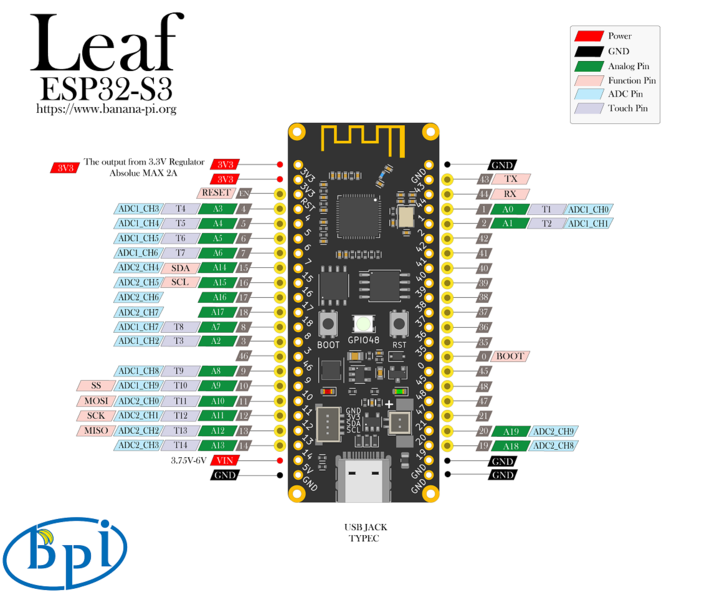Earlier this year, Banana Pi unveiled a series of new Microcontroller boards the BPI PicoW and BPI Leaf S3. While these boards share the same underlying ESP32-S3 MCU, they do possess key differences. In this article, we will embark on a thorough exploration of these boards, delving into their technical specifications and investigating their diverse range of applications.
1. BPI PicoW S3.
The Banana Pi BPI-PicoW-S3, part of a series of low-powered microcontrollers, is a board designed for IoT development and DIY projects. It shares the same size as the Raspberry Pi Pico board. This microcontroller enables 2.4 GHz Wi-Fi and Bluetooth® LE dual-mode wireless communication. It incorporates peripherals compatible with low-power hardware design, resulting in a mere 10uA power consumption in deep sleep mode.
In terms of programming, the PicoW-S3 supports ESP-IDF, Arduino IDE, Micropython, and other methods, allowing developers to choose the programming environment that best suits their needs.

| SoC | ESP32-S3, Xtensa® 32-bit LX7 dual core |
| Basic frequency | 240MHz MAX |
| Operating temperature | -40℃~+85℃ |
| On-chip ROM | 384KB |
| On-chip SRAM | 512KB |
| Extereal FLASH | 8MB |
| In-package PSRAM | 2MB |
| WiFi | IEEE 802.11 b/g/n, 2.4Ghz band, 150Mbps |
| Bluetooth | Bluetooth 5, Bluetooth mesh |
| GPIO | 27 |
| USB | MICRO |
| Input voltage | 3.3V~5.5V |
| Operating Voltage | 3.3V |
| Dimentions | 21mm(0.83″) × 51.88mm(2.04″) |
You can read more about the BPI PicoW S3 here.
Purchase links:
2. BPI Leaf S3.
Similar to the BPI PicoW S3, the BPI Leaf S3 operates using the renowned ESP32-S3 MCU, albeit with some notable distinctions. The main controller of the Leaf-S3 provides two power supply input options: a USB and an external 3.7V lithium battery. These inputs are interchangeable, allowing for flexible power configurations. Moreover, the battery can be charged while the USB is connected. Thanks to its compact size, versatile interface, and user-friendly design, the Leaf-S3 is an excellent choice for low-power IoT projects.
In terms of programming, the Leaf-S3 too supports ESP-IDF, Arduino IDE, Micropython, and various other methods.
The IO pins on the BPI-Leaf-S3 are identical to those of the Espressif ESP32-S3-DevKitC-1, enabling developers to seamlessly integrate peripherals supported by the DevKitC-1 onto the BPI-Leaf-S3.

| SoC | ESP32-S3, Xtensa® 32-bit LX7 dual core |
| Basic frequency | 240MHz MAX |
| Operating temperature | -40℃~+85℃ |
| On-chip ROM | 384KB |
| On-chip SRAM | 512KB |
| External FLASH | 8MB |
| In-package PSRAM | 2MB |
| WiFi | IEEE 802.11 b/g/n, 2.4Ghz band, 150Mbps |
| Bluetooth | Bluetooth 5, Bluetooth mesh |
| GPIO | 36 |
| USB | USB Type C |
| Input voltage | 3.3V~5.5V |
| Operating Voltage | 3.3V |
| Additiona Interfaces | Additional Interfaces |
| Dimensions | 26mm(1.02″) × 65.25mm(2.57″) |
You can read more about the BPI Leaf S3 here.
Purchase Link:
| Amazon Global | Banggood | Aliexpress |
Final Thoughts.
In conclusion, the BPI PicoW and BPI Leaf S3 Microcontroller boards from Banana Pi are quite powerful and versatile options for IoT development and DIY projects. While both boards are built upon the ESP32-S3 MCU, they showcase distinct characteristics that cater to various application requirements. Through our exploration of their technical specifications and diverse range of applications, we have gained valuable insights into the potential they offer.
Whether you are looking for a compact and low-power solution or seeking compatibility with ESP32-S3-DevKitC-1 peripherals, these boards provide flexibility and ease of use. With support for 2.4 GHz Wi-Fi, Bluetooth® LE, and compatibility with popular programming frameworks like ESP-IDF, Arduino IDE, and Micropython, the BPI PicoW and BPI Leaf S3 empower developers to unleash their creativity and bring innovative projects to life.
As technology continues to evolve, these Microcontroller boards serve as essential tools in the ever-expanding IoT landscape. Whether you are a seasoned developer or a curious enthusiast, the possibilities are endless with the BPI PicoW and BPI Leaf S3.


One thought on “BPI – PicoW & Leaf S3”